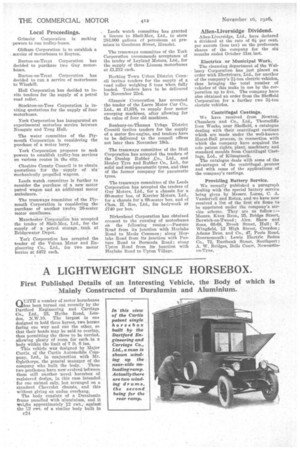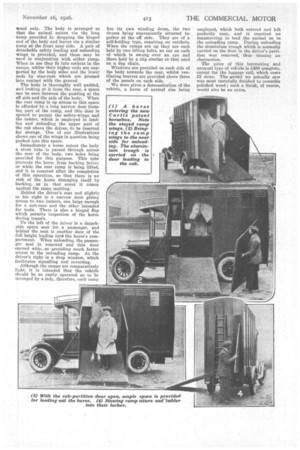A LIGHTWEIGHT SINGLE HORSEBOX.
Page 46

Page 47

If you've noticed an error in this article please click here to report it so we can fix it.
First Published Details of an Interesting Vehicle, the Body of which is Mainly Constructed of Duralumin and Aluminium.
QT_IITE a number of motor horseboxes has been turned out recently by the Dartford Engineering and Carriage Co., Ltd., 23, Hythe Road, 'London, N.W.10. The largest is one designed to hold three horses, two horses facing one way and one the other, so that their heads may be said to overlap, thus permitting the three to be carried, allowing plenty of room for each. in a body within the limit of 7 ft. 6 ins.
This vehicle was designed by Major Curtis, of the Curtis Automobile Cernpany, Ltd., in conjunction with Mr. Oglethorpe, the general manager of the company who built the body. These two gentlemen have now evolved between them still another novel horsebox of registered design, in this case intendedfor one animal only, but arranged on a standard Chevrolet chassis, and this without giving an undue overhang.
The body consists of a Duralumin frame panelled with aluminium, and it weighs approximately 32 cwt., against the 1,2 cwt. of a similar body built in
(324 wood only. The body is arranged so that the animal enters via the long ramp provided by dropping the hinged end of the body and leaves via a similar ramp at the front near side. A pair of detachable safety loading and unloading wings is provided, and these may be used in conjunction with either ramp. When in use they fit into sockets in, the ramps, whilst their higher ends are supported by the body sides and the lower ends by stay-rods which are pressed into contact with the ground.
The body is thoroughly well padded, and looking at it from the rear, a space can be seen between the padding at the off side and the side of the body. When the rear ramp is up access to this space is afforded by a long narrow door forming part of the ramp, and this door is opened to permit the safety-wings and the ladder, which is employed in loading and unloading the upper part of the cab above the driver, to be inserted for storage. One of our illustrations shows one of the wings in question being pushed into this space.
Immediately a horse enters the body a stout tube is passed through across the rear of the body, two holes being provided for this purpose. This tube prevents the horse from backing before or while the rear ramp is being lifted, and it is removed after the completion of this operation, so that there is no risk of the horse damaging itself by backing, as in that event it comes against the ramp matting.
Behind the driver's seat and slightly to his right is a narrow door giving access to two lockers, one large enough for a suit-case and the other intended for tools. There is also a hinged flap which permits inspection of the horse during transit.
To the left of the driver is a detachable spare seat for a passenger, and behind the scat is another door of the full height leading into the horse's compartment. When unloading, the passenger seat is removed and this door opened wide, so providing much better access to the unloading ramp. At the driver's right is a drop window, which facilitates signalling and reversing. Although the ramps are comparatively light, it is intended that the vehicle should be so easily operated as to be managed by a lady, therefore, each ramp has its own 'winding drum, the two drums being conveniently situated together at the off side. They are of a self-holding type, requiring no ratchets. When the ramps are up they are each held by two lifting bolts, an ear on each of which is swung over an eye and there held by a clip similar to that used on a dog chain.
Windows are provided on each side of the body towards the rear, whilst ventilating louvres are provided above three of the panels on each side.
We were given a demonstration of the vehicle, a horse of normal size being employed, which both entered and left perfectly easy, and it required no manmuvring to lead the animal on to the unloading ramp. During unloading the aluminium trough which is normally carried on the door in the driver's partition was removed, thus causing no obstruction.
The price of this interesting and unusual type of vehicle is £450 complete, except for the luggage rail, which costs £2 more. The Nroodel we actually saw was most tastefully finished to resemble polished wood; such a finish, of course, would also be an extra.












































































































